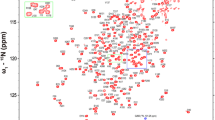Abstract
HdeA is a small chaperone found in the periplasm of several common pathogenic bacteria (Escherichia coli, Shigella flexneri and Brucella abortus) which are the leading causes of dysentery worldwide, especially in developing countries. Its job is to protect other periplasmic proteins from aggregating as the bacteria pass through the low pH environment of the human stomach on their way to infect the intestines. HdeA is an inactive folded dimer at neutral pH, but becomes a disordered active monomer at pH < 3. To initiate NMR characterization of HdeA at pH 6, 94 % of the backbone and 86 % of the side chain chemical shifts have been assigned. The loop linking helices B and C remains largely unassigned due to missing peaks in the 1H–15N HSQC and other spectra, most likely due to intermediate timescale chemical exchange. Many of the weakest intensity backbone peaks correspond to residues that surround this loop within the tertiary structure. Assignment experiments have therefore helped to provide preliminary clues about the region of the protein that may be most responsible for initiating unfolding as the pH drops, and constitute an important first step in improving our understanding of, and ultimately combatting, HdeA activity.


Similar content being viewed by others
References
Delaglio F, Grzesiek S, Vuister GW, Zhu G, Pfeifer J, Bax A (1995) NMRPipe: a multidimensional spectral processing system based on UNIX pipes. J Biomol NMR 6:277–293
Foit L, George JS, Zhang BW, Brooks CL 3rd, Bardwell JC (2013) Chaperone activation by unfolding. Proc Natl Acad Sci USA 110:E1254–E1262. doi:10.1073/pnas.1222458110
Gajiwala KS, Burley SK (2000) HDEA, a periplasmic protein that supports acid resistance in pathogenic enteric bacteria. J Mol Biol 295:605–612. doi:10.1006/jmbi.1999.3347
Hong W, Jiao W, Hu J, Zhang J, Liu C, Fu X, Shen D, Xia B, Chang Z (2005) Periplasmic protein HdeA exhibits chaperone-like activity exclusively within stomach pH range by transforming into disordered conformation. J Biol Chem 280:27029–27034. doi:10.1074/jbc.M503934200
Hong W, Wu YE, Fu X, Chang Z (2012) Chaperone-dependent mechanisms for acid resistance in enteric bacteria. Trends Microbiol 20:328–335. doi:10.1016/j.tim.2012.03.001
Johnson BA (2004) Using NMRView to visualize and analyze the NMR spectra of macromolecules. Methods Mol Biol 278:313–352. doi:10.1385/1-59259-809-9:313
Koebnik R, Locher KP, Van Gelder P (2000) Structure and function of bacterial outer membrane proteins: barrels in a nutshell. Mol Microbiol 37:239–253
Malki A, Le HT, Milles S, Kern R, Caldas T, Abdallah J, Richarme G (2008) Solubilization of protein aggregates by the acid stress chaperones HdeA and HdeB. J Biol Chem 283:13679–13687. doi:10.1074/jbc.M800869200
Tapley TL, Korner JL, Barge MT, Hupfeld J, Schauerte JA, Gafni A, Jakob U, Bardwell JC (2009) Structural plasticity of an acid-activated chaperone allows promiscuous substrate binding. Proc Natl Acad Sci USA 106:5557–5562. doi:10.1073/pnas.0811811106
Waterman SR, Small PL (1996) Identification of sigma S-dependent genes associated with the stationary-phase acid-resistance phenotype of Shigella flexneri. Mol Microbiol 21:925–940
Acknowledgments
The author would like to thank Dr. James Bardwell (University of Michigan) for kindly providing the HdeA-expressing plasmid, as well as the Department of Chemistry & Biochemistry and the College of Science and Mathematics at CSU Northridge for research support. The experiments were performed on a 600 MHz NMR spectrometer generously funded by NSF MRI grant CHE-1040134.
Conflict of interest
The author declares that she has no conflict of interest in the publication of this manuscript.
Author information
Authors and Affiliations
Corresponding author
Rights and permissions
About this article
Cite this article
Crowhurst, K.A. 13C, 15N and 1H backbone and side chain chemical shift assignment of acid-stress bacterial chaperone HdeA at pH 6. Biomol NMR Assign 8, 319–323 (2014). https://doi.org/10.1007/s12104-013-9508-0
Received:
Accepted:
Published:
Issue Date:
DOI: https://doi.org/10.1007/s12104-013-9508-0




